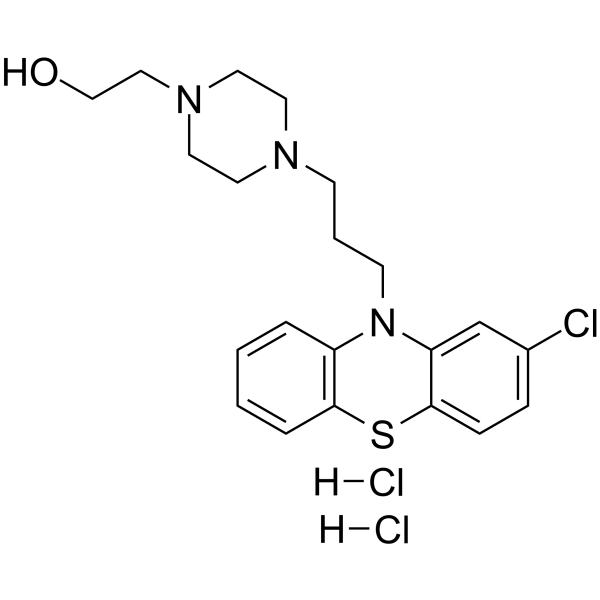2015-28-3
| Name | 2-[4-[3-(2-chlorophenothiazin-10-yl)propyl]piperazin-1-yl]ethanol,dihydrochloride |
|---|---|
| Synonyms |
Perphenazin-dihydrochlorid
EINECS 217-944-6 Perphenazine HCl Perphenazine dihydrochloride |
| Description | Perphenazine dihydrochloride is an orally active dopamine receptor and histamine-1 receptor antagonist, with Ki values of 0.56 nM (D2), 0.43 nM (D3), .6 nM (5-HT2A), respectively. Perphenazine dihydrochloride also binds to Alpha-1A adrenergic receptor. Perphenazine dihydrochloride inhibits cancer cell proliferation, and induces apoptosis. Perphenazine dihydrochloride can be used in the research of mental disease, cancer, inflammation[1][3][5]. |
|---|---|
| Related Catalog | |
| Target |
D2 Receptor:0.56 nM (Ki) D3 Receptor:0.43 nM (Ki) D4 Receptor:28.5 nM (Ki) 5-HT2A Receptor:5.6 nM (Ki) 5-HT6 Receptor:17 nM (Ki) 5-HT7 Receptor:23 nM (Ki) 5-HT2C Receptor:132 nM (Ki) 5-HT1A Receptor:421 nM (Ki) |
| In Vitro | Perphenazine dihydrochloride (40 μM, 48 h) inhibits cell viability, and induces cell apoptosis mediated by CTSD (Cathepsin D) in L02 cells[2]. Perphenazine dihydrochloride (30 μM, 24 h) induces intense lysosome vacuolation, impaired lysosomal membrane, and induces lysosomal membrane permeabilization (LMP), ultimately triggering lysosomal cell death in L02 cells[2]. Perphenazine dihydrochloride (10-40 μM, 24 h) inhibits autophagic flux in L02 cells[2]. Perphenazine dihydrochloride (1 µM, 24 h) decreases glioblastoma U-87 MG cell migration and invasion[4]. Cell Viability Assay[2] Cell Line: L02 cells Concentration: 10-100 μM Incubation Time: 12, 24, 48 h Result: Inhibited cell viability in a concentration and time-dependent manner. Western Blot Analysis[2] Cell Line: L02 cells Concentration: 10, 20, 30, and 40 μM Incubation Time: 24 h Result: Increased LC3 I/II and P62/SQSTM1 levels Cell Migration Assay [4] Cell Line: U-87 MG cells Concentration: 0, 3, 6, 9, 12, and 24 h Incubation Time: 0, 3, 6, 9, 12, and 24 h Result: Increased the wound closure in human glioblastoma cell cultures from 24.6 to 62.7%. |
| In Vivo | Perphenazine dihydrochloride (oral gavage, 180 mg/kg, every other day for 21 days) induces liver injury and lysosomal membrane damage in ICR mice[2]. Perphenazine dihydrochloride (oral administration, 10 mg/kg, every other day for 6 days) attenuates morphological phenotype in mouse models of Th2-type allergic dermatitis[3]. Animal Model: ICR mice[2] Dosage: 10, 30, 60, 120, 180 mg/kg Administration: Oral gavage, every other day for 21 days. Result: Increased histological injury and aminotransferases compared with control. Animal Model: Oxazolone-treated animal model of dermatitis[3] Dosage: 10 mg/kg Administration: Oral administration, every other day for 6 days Result: Decreased The levels of mice ear swelling. |
| References |
| Boiling Point | 580.4ºC at 760mmHg |
|---|---|
| Molecular Formula | C21H28Cl3N3OS |
| Molecular Weight | 476.89100 |
| Flash Point | 304.8ºC |
| Exact Mass | 475.10200 |
| PSA | 55.25000 |
| LogP | 5.48750 |
| Vapour Pressure | 2.6E-14mmHg at 25°C |
| Storage condition | 2-8°C |
